ƯỜ
Ấ
TR
NG TRUNG C P TÂY NGUYÊN
Ậ
Ỹ
KHOA K THU T
Ọ
Ầ
Ề
Ế
Đ THI K T THÚC H C PH N
ọ ầ ọ
Tên h c ph n: ầ Anh văn chuyên ngành Mã h c ph n:
ệ Chuyên ngành đào t o: ạ Công ngh thông tin
I/ CHOOSE THE BEST ANSWER:
B. main memory C. storage devices D.peripherals
C. output devices B. input devices D. a,b,c are right
C. Ram B. Rom D. all of them
1.The nerve centre of a microcomputer is……………………
A. CPU
2. The peripherals are ……………………………………….………
A. storage devices
3. When switched off, the information in the……………………..is lost.
A. CD disk
4. The results produced by a computer.
A. input C. floppy B. output D. periperals
C. secondary storage
D. a,b,c are right
C. picture element
D. personal computers
B. a byte C. a megabyte
D. All of them B. COBOL C. BASIC
D. a,b,c are wrong B. 1024 KB C. 1024 GB
D. seven B. five C.six
C. select and press D. select and save B. select and put
B. back space D. space bar C.enter
5. Information in the …………………….... is permanent and can not be deleted.
A. Rom
B. Ram
6. The “PC” stands for……………………………………….…….
A. peripheral component
B. program counter
7. 1s and 0s are grouped of eight digit codes called……………….………………
A. a bit
D. a gigabyte
8. High level languages are……………………………………………….
A. FORTRAN
9. One kilobyte is equavelent to………………………………………….……
A. 1024 B
10. There are …………………………………………steps in problem solving
A.four
11. The buttons on the mouse are used to………………….. ……………..items.
A. select and move
12. A long key at the bottom of the keyboard. Each time it is pressed it produces a blank
space. It is………………….
A. arrow key
13. It produces upper case character but it doesn’t affect numbers and symbols. It
B. alt D. escape C. capslock
C. escape D. space bar B. back space
D. alt C. return B. escape
D. alt C. return B. escape
C.escape B. back space
B. tab C.escape D. space bar
C.1960 B.1959 D. 1964
B. tab D. space bar C. escape
B. arrow keys D. space bar C. caplock
D. click B. slide C. drag
B. Rom C. Ram
B. 60 Hz C. 70 Hz D. 75 Hz
B. four C. five D. six
D. a,b,c are right C. directory B. sector
D. all of them C. CD disk B. Rom
D. 700 MB B. 500 MB C. 600 MB
C. three D. four B. two
is……….
A. Shift
14. It moves the cursor to the beginning of a new line. It is also used to confirm
commands. It is ……
A. enter
15. It stops a program without losing the information from the main memory.
Sometimes its use depends on the applications. It is ………………….
A. caplock
16. It works in combination with other keys to produce special characters or specific
actions
A. caplock
17. It removes the character on the left of the cursor or any selected text. It is….
A. arrow key
D. space bar
18. It produces UPPER CASE characters
A. shift
19. ALGOL was first introduced in......................
A. 1954
20. It moves the cursor horizontally to the right for a fixed number of space. It is ….
A. shift
21. They are used to move the cursor, as an alternative to the mouse. It is ….
A. shift
22. The mouse is designed to…………………………….... around on your desktop.
A. grab
23. What we see on the screen is created and stored in the area of…………………….
A. disks
D. a,b,c are wrong
24. The fast moving…………………” refresh rate” eliminates this annoying flickering.
A. 50 Hz
25. On colour displays, there are……….. electron guns at the back of the monitor’s
tube.
A. three
26. When you open a file, the operating system look for its entry in the…….. on the
disk.
A. track
27. When switched off, the information in the………………………..is lost.
A. Ram
28. A hard disk can hold avast amounts of information, from…. up to several gigabytes.
A.400 MB
29. There are…………….basic steps are involved in the process the data.
A. one
30. The programmer must translate the algorithm or flowchart into a computer program
is the ............ step.
C. fifth B. fourth D. sixth
B. main memory C. storage devices D. peripherals
B. hardware D. floppy
B. hardware C. port D. floppy
C. peripheral devices
D. Rom
A. third
31. The brain of the computer is…..
A. A. CPU
32. Physical parts that make up a computer system
A. software
C. port
33. Programs which can be used on a particular computer system
A. software
34. Hardware equipment attached to the CPU
A. CPU
B. Ram
35. Visual display unit
A. input C. floppy B. output D. monitor
B. input C. output D.peripheral divices
D. a& b C. commercial B. mathematical
C.A computer is useless without a
programmer to tell it what to do
D. A, B, C are true
36. Any socket or channel in a computer system into which an input/output device may
be connected
A. port
37. Fortran is used for solving..................problem.
A. scientific
38. Which statement best expresses the main idea of the text “ computer capabilities and
limitations
A.The most elaborate of computers must
be programmed in order to be useful
B.It is important to know what a computer
can and cannot do
39. Which statement best expresses the main idea of the text “programs and
programming languages.
A. Without sofware packages, it would be
difficult to use the computer in solving
problems such as payroll
C. Sour programs written in highlevel
languages have to be changed to machine
code before the computer can operate on
them
D. A, B, C are true
C. The computer does what the
programmer tells it to do
D. A, B, C are true
B. Compliers are indispensable to a
computer
40. Which statement best expresses the main idea of the text “Steps in problem solving”
A. Constructing an algorithm is the basic
step in solving a problem
B.Solving problems becomes easier if
certain steps are followed.
II/ THE STATEMENTS BELOW ARE TRUE (T) OR FAULT (F):
1. Computers are electronic machines that process information.
2. The Ram capacity can’t be expanded by adding extra chips.
3. The Ram capacity can be expanded by adding extra chips.
4. All information stored in the Ram is temporary.
5. All information stored in the Ram is permanent.
6. A CPU contains thousands of electronic circuits connected by switches.
7. We use KB, MB, GB to describe the Ram memory, the storage capacity of
8. We can put information into Rom.
9. We cannot put information into Rom.
10. Information is processed and stored in computer as electrical signals.
11. Sometimes, computers are use three or four digits instead of two digits.
12. If we don’t want to use this information later on, we don’t have to save it and
store it on a disk.
13. If we want to use this information later on, we don’t have to save it and store
disk…
14. Ram, Rom and secondary storage are the components of the main memory.
15.
it on a disk.
16. The speed of the microprocessor is measured in megahertz. One MHz is
17.
Information can not be processed by the microprocessor if it is not loaded into
the main memory
18. The cathode ray tube of monitor isn’t similar to that of a TV set.
19. A mouse is smaller than a pack of cards but its function is powerful.
20. The high resolution gives us a sharp image.
21. The disks must be initialized or formatted before information can be recorded
equivalent to one million cycles per second.
“Seek time” refers to the average time required for the recording heads to
move and access data.
22. Information in the Rom can be changed and are erased when the power is turned
onto it.
23. Information in the Rom cannot be changed and are erased when the power is
off.
24. Mice can’t do difficult thing in graphic applications.
25. Lap top use a flat liquid crystal display instead of a picture tube.
26.
turned off.
27. A computer cannot do anything until it has been programmed.
28. A computer is a useless machine if its capabilities and limitations are
29.
If you use multimedia applications, you need the same storage capacity as
required for word processors.
unknown
A computer can think and solve problems by itself.
30. A computer usually solves problems by doing some mathematical and
31. Computers donot usually make mistakes unless they break down.
32. BASIC was developed to help students
33. All high level programs must be translated to machine code before the
decision making operations.
34. An operating system program controls input and output operations.
35. Different high level languages suit different problems.
36. The most important part of problem solving is defining the problem clearly.
37. A computer is very intelligent. It is capable of thinking.
38. An algorithm is a sequence of instructions used to solve a problem
39. The computer is a great help to people because it solves their problems.
40. All problems are equally difficult to solve.
computer can execute them.
III. TRANSLATE THESE SENTENCES INTO VIETNAMES
1. A standard computer system consists of three main sections: the central processing
unit (CPU), the main memory and the peripherals.
2. The function of CPU is to execute program instructions and coordinate the
activities of all other units. it is the “brain” of the computer.
3. The nerve centre of a microcomputer is the central processing unit or CPU. This
unit is built into a single microproceesor chip an intergrated circuit which
executes program instructions and supervises the computer’s overall operation.
4. Information is processed and stored in computers as electrical signals. A computer
contains thousands of electronic circuits connected by switches.
5. 1s and 0s are grouped into eight digit codes that typically represent characters
6.
( letters, numbers and symbols). Eight bits together are called a byte.
In order to avoid astronomical figures and sums in the calculation of bytes, we use
units such as kilobytes, megabytes and gigabytes. One kilobyte is 1,024 bytes .
One megabyte is equivalent to 1,024 KB, and one gigabyte is 1,024 MB.We use
these units (KB, MB, GB) to describe the RAM memory, the storage capacity to
disks and the size of any application or document.
7. Ram (random access memory) is temporary i.e. Its information is lost when the
computer is turned off. However, the Rom section ( read only memory) is
permanent and contains instructions needed by the processor.
8. The size of RAM is very important if we want to increase the performance of a
computer when several applications are open at the same time or when a document
is very complex.
9. Information stored on magnetic disk can retrieved faster than if that same
information were on tape.
10. A program written in one of the high level languages is called a source program.
11. The extension of internal storage in order to increase the capacity of primary
memory is called virtual storage.
12.The surface of a floppy disk is divided into concentric circles or “tracks”, which
are then divided into “ sectors”.
13.“Access time” is the time it takes your read/ write head to find any particular
record and “data transfer rate” is the average speed required to transmit data from
a disk system to the Ram.
14. The total number of pixels in which the display is ivided both horizontally and
vertically is known as the resolution.
15. If you work in an office with a large number of computers, don’t sit too close to
the sides or backs of the monitors.
16. The nerver centre of a microcomputer is the centre processing unit or CPU. The
unit consits of three main parts:
The control unit
The arithmetic logic unit
The registers
17.Software is information in the form of data and programs, hardware is
the electronic and mechanical parts that make up a computer system
18. The registers, which are high speed units of memory used to store and control
information. There are two registers. They are program counter (PC) and
instruction register (IR) . Program counter which keeps track of the next
instruction to be performed in the main memory, instruction register (IR) which
keeps the instruction that is being executed.
19.According to the writer, The importance of “pixel resolution” decides the quality
of image.
20.When you save a file, the operating system moves the read/ write heads of the disk
drive towards empty sectors, records the data and writes an entry for the directory.
21. When you open the file, the operating system looks for its entry in the directory on
the disk, moves the read/ write heads to the correct sectors, and reads the file into
the RAM area.
22.If you only use word processing programs, you will need less storage capacity
than if you use CAD.
23.Microcomputers make use of two types of main memory: RAM and ROM, both
contained in electronic chips connected to the mainboard of the computer.
24.RAM is the working area of the computer, that is the basic location where the
microprocessor stores the required information.
25.We use these units (KB, MB, GB) to describe the RAM memory, the storage
capacity of disks and the size of any application or dorcument.
The mouse also issues instructions to the computer very quickly
Mice are so widely used in graphics applications.
26. the advantages of the computer mouse over the keyboard are
it is very quick way to move around on a screen
28. Can a computer solve problems? Definitely not. It is a machine that carries out
the procedures which the programmer gives it. It is the programmer then who
solves the problems.
27 . Source programs written in high level languages have to be changed to machine
code before the computer can operate on them.
30. Constructing an algorithm is the basic step in solving a problem.
31. Punched cards are the only way of transferring the program to the computer
32.
29. There are six steps to solve a problem.
Step 1: The programmer must be define the problem clearly.
Step 2: The programmer must formulate an algorithm.
Step 3: The programmer must translate the algorithm into a computer program.
Step 4: The programmer must then keypunch the program or give the coding sheets to
the keypunch operator to do it.
Step 5: The program must then be tested.
Step 6: Add the data to the program and run the job completely.
33. An algorithm is a sequence of instructions used to solve a problem.
34. All high level programs must be translated to machine code before the
memory.
If the data is not added to the program, the computer cannot perform
calculation.
computer can execute them.
35. Different high level languages suit different problems.
36.
37. A computer is a useless machine if its capabilities and limitations are
It is a must for a programmer to be helped to understand machine code.
38. A computer usually solves problems by doing some mathematical and
unknown.
39. Computers do not usually make mistakes unless they break down.
40. A computer is useless without a programmer to tell it what to do.
decision making operations
1. What’s computer?
2. How many steps are there in a process? What are they?
3. What’s software?
4. What’s hardware?
5. How many sections are there in a standard computer system?
What are they?
6. What’s the function of CPU?
7. What’s the function of main memory?
8. What are peripherals?
IV/ ANSWER THE QUESTION BELOW
9. How many parts in peripherals? What are they?
10. How many parts are there in a CPU? What are they?
11. What’s the function of control unit?
12. What are registers?
13. How many registers are there? What are they?
14. How many types of main memory? What are they?
15. What does “RAM” stand for?
16. What memory section is also known as “firm ware” ?
17. What information is lost when the computer is switched off?
18. What is the typical unit used to measure RAM memory and storage memory?
19. How many digits does a binary system use? What is bit?
20. What’s a collection of eight bits called?
21. How is the mouse connected to the computer?
22. What does the mouse pointer look like on the screen?
23. What are the functions of the mouse button?
24. What are the advantages of a computer mouse over the key board?
25. What’s the importance of “pixel resolution” ?
26. Which unit of frequency is used to measure the refresh rate of a monitor?
27. What substance is hit by electrons in a monitor?
28. What is the standard display system for many personal computer?
29. What does “LCD” stand for? What type of computers use LCD displays?
30. What’s access time/ seek time?
31. What’s data transfer rate?
32. What are the advantages of hard disks over floppies?
33. What’s the main function of a hard disk?
34. Which units is used to measure hard disk capacity?
35. What does “CD ROM” stand for?
36. What is the main idea of the text “Computer capabilities and limitations” ?
37. What is the main idea of the text “ Steps in problem solving” ?
38. How many steps are there in problem solving?
39. What’s the basic step in solving a problem?
40. What is source program?
Ự Ậ Ổ Ợ Ề
QUY TRÌNH T H P Đ THI T LU N
ọ ề ượ ử ụ ệ ầ
(Đ thì h c ph n này không đ c s d ng tài li u)
ế ề ầ ọ ờ ồ Đ thi k t thúc h c ph n có th i gian thi là 90 phút; g m 40câu trong đó:
ọ ả ờ ấ
i đúng nh t trong 4 Choose the best answer. (Ch n câu tr l
ể
ầ
ỗ
ầ ị he statements below are true (t) or fault (f). (Xác đ nh xem
ẫ ể ỗ M i câu 02,5 đi m)
ế ầ ị
ể ỗ t, ệ M i câu 02,5 đi m)
ả ờ ỗ
ỏ M i câu i câu h i,
10 câu ph n I/
đáp án, M i câu 02,5 đi m)
10 câu ph n II/ T
câu m u đúng hay sai,
10 câu ph n III/ Translate these sentences into vietnames. (D ch sang Ti ng
vi
ầ
10 câu ph n IV/ Answer the question below. ( Tr l
02,5 đi m)ể
ộ
Buôn Ma Thu t, ngày 20 tháng 3 năm 2014
Ộ
Ề
ƯỞ
GIÁO VIÊN RA Đ THI B MÔN ............ TR
NG KHOA
Ự Ậ Ề ĐÁP ÁN Đ THI T LU N
1. A
2. D
3. C
4. B
5. A
6. B
7. B
8. D
9. A
10. C
11. A
12. D
13. C
14. A
15. B
16. D
17. B
18. A
19. C
20. B
21. B
22. B
23. C
24. D
25. A
26. C
27. A
28. B
29. C
30. A
31. A
32. B
33. A
34. C
35. D
36. A
37. D
38. B
39. C
40. C
I/ CHOOSE THE BEST ANSWER.
II/ THE STATEMENTS BELOW ARE TRUE (T) OR FAULT (F):
Answer Correct
1. T
The Ram capacity can be expanded by adding extra chips. 2. F
3. T
4. T
5. F All information stored in the Ram is temporary
6. F
A computer contains thousands of electronic circuits connected by
switches.
7. T
8. F We cannot put information into Rom.
9. T
10. T
11. F
we have to use binary notation because this is the only way computers
can understand anything.
12. T
13. F
14. F
If we want to use this information later on, we have to save it and
store it on a disk.
Ram, Rom are the components of the main memory.( secondary
storage aren’t the components of the main memory).
15. T
16. T
17. T
18. F The cathode ray tube of monitor is similar to that of a TV set.
19. T
20. T
21. T
22. F
Information in the Rom cannot be changed and are erased when the
power is turned off.
23. T
24. F Mice can do difficult thing in graphic applications.
III/ TRANSLATE THESE SENTENCES INTO VIETNAMES.
ơ ầ ẩ ị ử
ộ ệ ố
ớ
ủ ươ ố ợ ế ị
ự
ộ ộ ủ
ộ ạ ử ậ
ủ
ở
ộ ệ ạ ộ ộ
ươ ề
ượ ạ
c t o nên b i m t con chip vi x lí đ n m t m ch tích
ệ ị ử
ơ
ng trình và giám sát toàn b ho t đ ng
ệ ệ ữ
ư
ạ
ạ ữ ữ
ố ữ ệ
ượ ể ượ ạ
i thì đ ng). 8 bit h p l Thông tin đ
ồ
ố
ố
( là các ch cái, con s , bi u t
ổ ớ ể ủ ử
Đ tránh con s quá l n và t ng các phép tính c a byte . Chúng ta s
ộ ơ
ộ ằ ố
ị ư
ộ
ử ụ ị ư ằ
ộ
ư ể
ụ ứ
ữ ủ
ậ ỡ ủ
ạ ẫ
ố ị ứ ộ
ng l u tr c a đĩa và kích c c a các ng d ng
ị ấ
ớ
ờ
Ram(b nh truy c p ng u nhiên) là t m th i nghĩa là thông tin b m t
ị ắ
ớ ỉ ọ
t, tuy nhiên Rom ( b nh ch đ c) thì c đ nh và ch a các
t cho quá trình x lí.
ế
ượ ử
ấ ự ự ủ
ố
ờ ứ ể ộ ộ
ệ ủ
ệ
ượ ư ừ ụ ể ơ có th truy l c nhanh h n thông tin c l u tr trong đĩa t
ượ ư
ộ ế ằ ữ ậ t b ng m t trong các ngôn ng l p trình
ữ
ừ
.
ượ
ươ
ộ
c vi
ồ
ng trình ngu n.
ằ ủ ộ ượ ộ ớ ớ
Ph n m r ng c a b nh trong nh m tăng dung l ng b nh chính
c l u tr trong băng t
ươ
ng trình đ
ượ ọ
c g i là ch
ở ộ
ớ ả ọ
ượ ồ ọ c chia thành các vòng tròn đ ng tâm hay còn g i
ượ
ề
c chia thành các cung.
ờ ả
ọ
ầ
ể ữ ệ ừ ậ
ố ộ
ộ ọ ượ ả ị c chia thành hàng ngang và c t d c thì
ả i.
ổ
ượ ọ
ế ớ ố ượ ớ ng máy tính l n thì
ố ơ
ộ
c g i là đ phân gi
ệ
ạ
ầ ặ ằ ạ ồ ồ
1. M t h th ng máy tính chu n bao g m 3 ph n chính: đ n v x lí trung
ạ
ộ
t b ngo i vi.
tâm, b nh chính và các thi
ệ
ệ
ứ
ng trình và ph i h p
Ch c năng c a CPU là th c hi n các l nh ch
2.
ủ
ượ ọ
ạ ộ
các ho t đ ng c a các b ph n khác. Nó đ
c g i là b não c a máy tính.
ơ
Trung tâm đi u hành c a máy vi tính là đ n v x lí trung tâm hay CPU.
3.
ậ
ộ
B ph n này đ
ự
ợ
h p cái mà th c hi n các l nh ch
ủ
c a máy tính
ượ ử
ộ
c x lí và l u tr trong máy tính là các tín hi u đi n. M t
4.
ắ
ở
ệ ượ ố ớ
máy tính bao g m hàng ngàn m ch đi n đ
c n i v i nhau b i các công t c.
ố
ộ
Nh ng s 1 và nh ng s 0 t o thành m t nhóm 8 mã s thì đ i di n
5.
ợ ạ
ự
ộ
cho m t ký t
c
ọ
g i là 1 byte.
6.
ụ
d ng các đ n v nh kilobyte, megabytes and gigabytes. M t kilobyte thì
ằ
b ng 1024 byte, m t megabyte b ng 1024 kilobyte, m t gigabyte b ng 1024
ớ
ơ
megabyte. Chúng ta s d ng các đ n v nh KB, MB, GB đ đo b nh
ượ
Ram, dun g l
ộ
7.
khi máy tính b t
ầ
ệ
l nh c n thi
ế
ọ
ng c a Ram r t quan tr ng n u chúng ta mu n tăng s th c
Dung l
8.
ở
ụ
hi n c a máy tính khi m t vài ng d ng m ra cùng m t th i đi m hay khi
ứ ạ
tài l u ph c t p.
Thông tin đ
9.
ữ
đ
10. M t ch
ậ
b c cao thì đ
ầ
11.
ộ
ta g i là b nh o
ề ặ
12. B m t đĩa m m đ
là rãnh. Sau đó đ
ố ộ
ờ
13. Th i gian truy c p là th i gian mà đ u đ c ghi tìm b n ghi, t c đ
ế
ệ ố
ề ữ ệ
đĩa h th ng đ n
truy n d li u là t c đ trung bình chuy n d li u t
Ram.
14. T ng s đ n v hình nh đ
đ
ộ
15. N u b n làm vi c trong m t văn phòng v i s l
không nên ng i quá g n phía bên c nh ho c đ ng sau màn hình.
ộ ử ộ
ậ ề
ầ
ủ
16. Trung tâm đi u hành c a máy vi tính là b x lí trung tâm hay CPU. B
ph n này g m 3 ph n chính:
ộ
ơ
ồ
ể
ề
ậ
B ph n đi u khi n
ị ố ọ
Đ n v s h c logic
Các thanh ghi
Ph n m m là nh ng thông tin
ữ ề ầ ầ ươ ng trình. Ph n ữ ệ
d ng d li u và ch
ầ ệ
ầ
ộ ở ạ
ạ
ớ
ộ
ắ ớ
ệ c
ệ ệ ự ế
ắ
ọ ế ị ự
ả ươ
ng trình n m gi
ẽ ượ
ệ
ữ ữ
nh ng l nh s đ
ả
ủ ộ i hình nh quy t đ nh
ấ ượ ả ầ
t m quan tr ng c a đ phân gi
ả
ng hình nh.
ủ ể ầ ọ
ồ ế ữ ộ ậ
ế ụ ạ ư
đĩa đ n cung r ng r i vi
ạ ả
ế
ồ ọ ậ ả
ệ ề
ớ ụ ồ ứ ọ i cung ch a nó r i đ c t p tin ra vùng
ạ ầ ươ
ỉ ử ụ
ạ ử ụ ế
ơ ạ
ế ươ ẽ ử
ng trình v và thi ng h n n u b n s d ng ch
ả
ng trình x lý văn b n, b n c n ít dung
ế ế ằ
t k b ng máy tính.
ả ớ ề ứ ộ ộ ớ
ệ ử ế ố ớ ủ ạ
k t n i v i bo m ch chính c a máy tính.
ơ ả ủ ệ ơ ộ ị
ữ ữ ượ ầ
ử ụ ả ộ ể ớ b nh Ram, dung
ụ ủ ệ
17.
ệ ố
ứ
c ng là ph n đi n và ph n máy cái mà t o nên h th ng máy tính.
ể ư
ể
ề
ữ
ậ ủ ộ
18. Thanh ghi là các b ph n c a b nh dùng đ l u tr và đi u khi n
ươ
ế
ng trình và
thông tin v i tôc đ cao. Có 2 thanh ghi là thanh ghi đ m ch
ượ
ệ
ữ ữ
nh ng l nh đã đ
thanh ghi l nh. Thanh ghi đ m ch
ệ
th c hi n, thanh ghi l nh n m gi
c th c hi n
19. Theo tác gi
ch t l
ệ ề
20. Khi b n l u tr m t t p tin, h đi u hành di chuy n đ u đ c/ ghi c a
ổ
ỗ
t ra b ng danh m c.
ở ộ ậ
21. Khi b n m m t t p tin, h đi u hành tìm ki m nó trong b ng danh
ầ
ể
m c r i di chuy n đ u đ c/ ghi t
Ram.
22. N u b n ch s d ng ch
ượ
l
23. Máy vi tính có 2 b nh chính: RAM và ROM, c hai b nh đ u ch a
các chip đi n t
ử
24. Ram là vùng hi n hành c a máy tính, là v trí c b n n i mà b vi x lý
ư
c yêu c u.
l u tr nh ng thông tin đ
ị
ơ
25. Chúng ta s d ng các đ n v KB, MB, GB đ mô t
ỡ ủ ứ
ượ
ng c a đĩa và kích c c a ng d ng, tài li u.
l
ộ ơ
26. Thu n l
ậ ợ ủ
ớ
ụ ồ ọ ệ
ử ụ i máy tính.
ứ
ươ ậ ả
i c a chu t h n bàn phím là:
ể
Di chuy n nhanh trên màn hình
Phát l nh nhanh t
ộ
S d ng r ng rãi trong các ng d ng đ h a.
ữ ậ
ế ằ
ồ ượ
t b ng các ngôn ng l p trình b c cao ph i
ng trình ngu n đ
ể ử
c khi máy tính có th x lý.
c chuy n thành mã máy tr
ể ả ọ ấ c m i v n đ không? Hoàn toàn không. Máy
ề
ư ậ ậ
27. Ch
ể
ượ
đ
28. Máy tính có th gi
ỉ ự
ệ
ch th c hi n nh ng th t c do l p trình viên đ a vào và chính l p trình viên
ườ
ớ
m i là ng
29. Có sáu b
ọ ấ
ộ ấ
ả
ả
ả ướ
ướ
ướ ấ
ậ
ậ ư ồ ươ c vi
ướ
ế ượ
i quy t đ
ủ ụ
ữ
ề
ế
ả
i quy t m i v n đ .
i gi
ề
ướ ể ử
c đ x lý m t v n đ :
ị
ậ
B c 1: L p trình viên ph i xác đ nh rõ v n đ
ế ậ
ậ
B c 2: L p trình viên ph i thi
t l p thu t gi
ị
ậ
B c 3: L p trình viên ph i biên d ch thu t gi ề
ả
i
ả
i hay l u đ thành ch ng
ủ
trình c a máy.
B c 4: L p trình viên ph i nh p l nh ch
ự
ậ ệ ươ ư
ng trình hay đ a trang mã cho
ướ
ườ ậ
ậ ệ ả
ệ
i nh p li u th c hi n ng
ươ ử ng trình
B c 5: Sau đó, ph i th nghi m ch
B c 6: Đ a d li u vào ch
ả
ư ữ ệ ướ
ướ ạ ươ ộ ệ
ươ
ng trình và ch y ch ng trình m t cách
hoàn h oả
ự ậ ướ ơ ả ệ ả ộ ấ ế 30. Xây d ng thu t toán là b ấ
c c b n nh t trong vi c gi i quy t m t v n
đ .ề
ể ể ấ ươ ớ ủ ế ộ 31. Punched card là cách duy nh t đ chuy n ch ng trình đ n b nh c a
máy tính
ươ ượ ư c đ a vào ch ể
ng trình thì máy tính không th
ự c các phép tính
ỗ ộ ế ệ ộ ấ ể ả ượ ử ụ ế ữ ệ
ệ ượ
ậ i quy t m t v n c s d ng đ gi
ấ ả ả ượ ị c d ch sang mã máy
ữ ậ
c khi máy tính có th x lý chúng.
ữ ậ ữ ề ấ ớ ợ
ả ượ ự ợ
ụ ế ả ạ ể ể
c s tr giúp đ hi u mã máy
ế ượ
t đ ế
c kh năng và h n ch
ế ấ ườ ự ệ ả ộ ố
i quy t v n đ b ng cách th c hi n m t s
ề ằ
ạ ộ ọ
ị ỗ ừ
i tr khi chúng b h ng.
ậ ế ị
ng xuyên b l
ế
ụ ượ ậ ộ 32. N u d li u không đ
th c hi n đ
33. Thu t toán là m t chu i các l nh đ
đ .ề
ữ ậ
34. T t c các ngôn ng l p trình b c cao ph i đ
ể ử
ướ
tr
35. Nh ng ngôn ng l p trình khác nhau phù h p v i nh ng v n đ khác
nhau.
ộ ậ
36. M t l p trình viên ph i đ
ộ
37. M t máy tính là vô d ng n u ta không bi
ủ
c a nó.
ộ
ng gi
38. M t máy tính th
ư
phép tính toán h c và đ a ra quy t đ nh ho t đ ng.
ườ
39. Máy tính không th
40. M t máy tính là vô d ng n u không đ ị ỏ
c l p trình viên l p trình.
1. Computers are electronic machines which can accept data in a certain form,
IV/ ANSWER THE QUESTION BELOW
2. There are three basic steps are involved in the process. First step is fed into the
computer’s memory, second step is , when the program is run, the computer
performs a set of instructions and processes the data, finally step is we can see
the results on the screen or in printed form.
3. Software is Information in the form of data and programs.
4. Hardware is the electronic and mechanical parts that make up a computer
process the data and give the results.
5. There are three sections. They are CPU, main memory and peripherals.
6. The function of CPU is to execute program instructions and coordinate the
7.
system.
8. peripherals are the physical units attached to the computer.
9. There are three parts in peripherals.They are storage devices, input devices and
activities of all other units.
the function of main memory holds the instructions and data which are being
processed by the CPU.
10. There are three parts. They are control unit, arithmetic logic unit, registers.
output devices.
11. The function of control unit are: examines the instructions in the user’s
12. The registers are high speed units of memory used to store and control
program, interprets each instruction and causes the circuits and the rest of the
components
13. There are two registers. They are program counter and instruction register.
14. There are two main memory. They are Ram and Rom.
15. RAM stands for Random access memory.
16. The ROM section is also known as “firm ware”
17. Information in the RAM is lost when the computer is switched off.
18. They are KB, MB,GB.
19. There are two digits. Bit is a basic units of memory.
20. A collection of eight bits is called a byte
21. A “tail” or wire extends from the mouse to a connection on the back of the
information
22. The pointer usually looks like an arrow or I bar
23. the functions of the mouse buttons are movement, selection
24. The advantages of the computer mouse over the keyboard are
it is very quick way to move around on a screen
The mouse also issues instructions to the computer very quickly
Mice are so widely used in graphics applications.
25. The importance of resolution decides quality of image.
26. It’s Hz.
27. They are phosphors.
28. VGA (Video graphic array) is the standard display system for PCs.
29. LCD stands for liquid crystal display. The portable computer or Lap top use
computer
30. “Access time” or “seek time” is the time it takes your read/ write heads to find
LCD display
31. “Data transfer rate” is the average speed required to transmit data from a disk
any particular record.
32. The advantages of hard disks over floppies are:
system to the RAM.
Hard disks work faster than floppy disks.
They have a longer data life.
They can store huge amounts of information.
33. The main function of a hard disk is provide permanent storage for both data
34. They are KB, MB, GB.
35. “CD ROM” stand for compact disk read only memory.
36. The main idea of the text “Computer capabilities and limitations” is It is
and programs.
important to know what a computer can and cannot do.
37. The main idea of the text “ Steps in problem solving” is The computer does
what the programmer tells it to do.
38. There are six steps in problem solving.
39. Constructing an algorithm is the basic step in solving a problem.
40. A program written in one of the high level languages is called a source
program.
Ộ
Ề
ƯỞ
GIÁO VIÊN RA Đ THI B MÔN ............ TR
NG KHOA
…


![Đề thi Tin học văn phòng nâng cao học kì 1 năm 2020-2021 có đáp án [mới nhất]](https://cdn.tailieu.vn/images/document/thumbnail/2025/20250401/lakim0906/135x160/8491743477174.jpg)

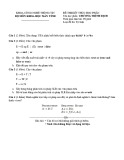
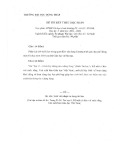
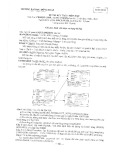
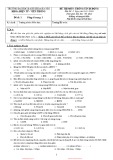
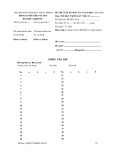
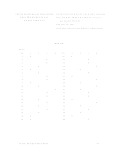
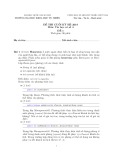
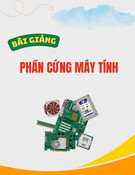












![Bài giảng Tổ chức - Cấu trúc Máy tính II Đại học Công nghệ Thông tin (2022) [Mới Nhất]](https://cdn.tailieu.vn/images/document/thumbnail/2025/20250515/hoatrongguong03/135x160/8531747304537.jpg)

